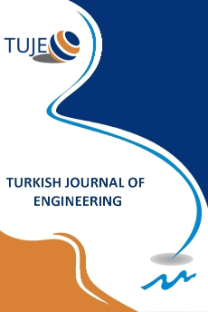Production of new type insulation material: Expanded Perlite-Silica aerogel composite
Production of new type insulation material: Expanded Perlite-Silica aerogel composite
Expanded Perlite, Silica aerogel, Insulation building material,
___
- ALOthman Z A (2012). A review: Fundamental aspects of silicate mesoporous materials. Materials, 5(12), 2874-2902. DOI: 10.3390/ma5122874
- Aravind P R, Shajesh P, Soraru G D & Warrier K G K (2010). Ambient pressure drying: A successful approach for the preparation of silica and silica based mixed oxide aerogels. Journal of Sol-Gel Science and Technology, 54(1), 105-117. DOI: 10.1007/s10971-010-2164-2
- Başgöz Ö & Güler Ö (2020). The unusually formation of porous silica nano-stalactite structure by high temperature heat treatment of SiO2 aerogel synthesized from rice hull. Ceramics International, 46(1), 370-380. DOI: 10.1016/j.ceramint.2019.08.271
- Feng Q, Chen K, Ma D, Lin H, Liu Z, Qin S & Luo Y (2018). Synthesis of high specific surface area silica aerogel from rice husk ash via ambient pressure drying. Colloids and Surfaces A: Physicochemical and Engineering Aspects, 539, 399-406. DOI: 10.1016/j.colsurfa.2017.12.025
- Gregg S J, Sing K S W & Salzberg H W (1967). Adsorption surface area and porosity. Journal of the Electrochemical Society, 114(11), 279C.
- Kistler S S (1931). Coherent expanded aerogels and jellies. Nature, 127, 741(3211). DOI: 10.1038/127741a0
- Kistler S S (1932). Coherent expanded-aerogels. Rubber Chemistry and Technology, 5(4), 600-603. DOI: 10.5254/1.3539386
- Li C, Cheng X, Li Z, Pan Y, Huang Y & Gong L (2017). Mechanical, thermal and flammability properties of glass fiber film/silica aerogel composites. Journal of Non-Crystalline Solids, 457, 52-59. DOI: 10.1016/j.jnoncrysol.2016.11.017
- Liou T H & Yang C C (2011). Synthesis and surface characteristics of nanosilica produced from alkali-extracted rice husk ash. Materials science and engineering: B, 176(7), 521-529. DOI: 10.1016/j.mseb.2011.01.007
- Ma X, Zhou B, Gao W, Qu Y, Wang L, Wang Z, & Zhu Y (2012). A recyclable method for production of pure silica from rice hull ash. Powder Technology, 217, 497-501. DOI: 10.1016/j.powtec.2011.11.009
- Nurkowski D, Buerger P, Akroyd J, Mosbach S & Kraft M (2016). Skeletal chemical mechanism of high-temperature TEOS oxidation in hydrogen–oxygen environment. Combustion and Flame, 166, 243-254. DOI: 10.1016/j.combustflame.2016.01.025
- Pichór W & Janiec A (2009). Thermal stability of expanded perlite modified by mullite. Ceramics International, 35(1), 527-530. DOI: 10.1016/j.ceramint.2007.10.008
- Stolarski M, Walendziewski J, Steininger M & Pniak B (1999). Synthesis and characteristic of silica aerogels. Applied Catalysis A: General, 177(2), 139-148. DOI: 10.1016/S0926-860X(98)00296-8
- Tang X, Sun A, Chu C, Yu M, Ma S, Cheng Y, Guo J & Xu G (2017). A novel silica nanowire-silica composite aerogels dried at ambient pressure. Materials & Design, 115, 415-421. DOI: 10.1016/j.matdes.2016.11.080
- Wang J, Zhang Y, Wei Y & Zhang X (2015). Fast and one-pot synthesis of silica aerogels via a quasi-solvent-exchange-free ambient pressure drying process. Microporous and Mesoporous Materials, 218, 192-198. DOI: 10.1016/j.micromeso.2015.07.019
- Wang L, Li Z, Jing Q & Liu P (2018). Synthesis of composite insulation materials—expanded perlite filled with silica aerogel. Journal of Porous Materials, 25(2), 373-382. DOI: 10.1007/s10934-017-0448-4
- Yang H, Li C, Yue X, Huo J, Ye F, Liu J, Shi F & Ma J (2020). New BN/SiOC aerogel composites fabricated by the sol-gel method with excellent thermal insulation performance at high temperature. Materials & Design, 185, 108217. DOI: 10.1016/j.matdes.2019.108217
- Zhou T, Cheng X, Pan Y, Li C, Gong L & Zhang H (2018). Mechanical performance and thermal stability of glass fiber reinforced silica aerogel composites based on co-precursor method by freeze drying. Applied Surface Science, 437, 321-328. DOI: 10.1016/j.apsusc.2017.12.146
- Zulfiqar U, Subhani T & Husain S W (2015). Towards tunable size of silica particles from rice husk. Journal of Non-Crystalline Solids, 429, 61-69. DOI: 10.1016/j.jnoncrysol.2015.08.037
- ISSN: 2587-1366
- Yayın Aralığı: Yılda 4 Sayı
- Başlangıç: 2017
- Yayıncı: Mersin Uüniversitesi
Seçkin ÇELİKER, Esra Saraç EŞSİZ, Murat OTURAKÇI
MICROSTRUCTURAL ANALYSIS OF ZnO-CuPc NANOCOMPOSITES SYNTHENISED BY HYDROTHERMAL METHOD
İskender ÖZKUL, Canan Aksu CANBAY, Rekawt Khdir HAMAD
Production of new type insulation material: Expanded Perlite-Silica aerogel composite
Ömer GÜLER, Öyküm BAŞGÖZ, Çağdaş YAVUZ
PIONEERING INSTITUTIONS IN SECTOR ON REAL ESTATE APPRAISAL
Fatih TAKTAK, Mahir Serhan TEMİZ
CLIENT SATISFACTION AS PERCEIVED BY ARCHITECTS AND CIVIL ENGINEERS
Rekawt Khdir HAMAD, Canan AKSU CANBAY, İSKENDER ÖZKUL
Fatih TAKTAK, Mahir Serhan TEMİZ
TEMPORAL MONITORING OF LAND USE/LAND COVER CHANGE IN KAHRAMANMARAS CITY CENTER
Kubra ALİYAZİCİOGLU, Fatmanur BEKER, Raziye Hale TOPALOĞLU, BURHAN BAHA BİLGİLİOĞLU, RESUL ÇÖMERT
